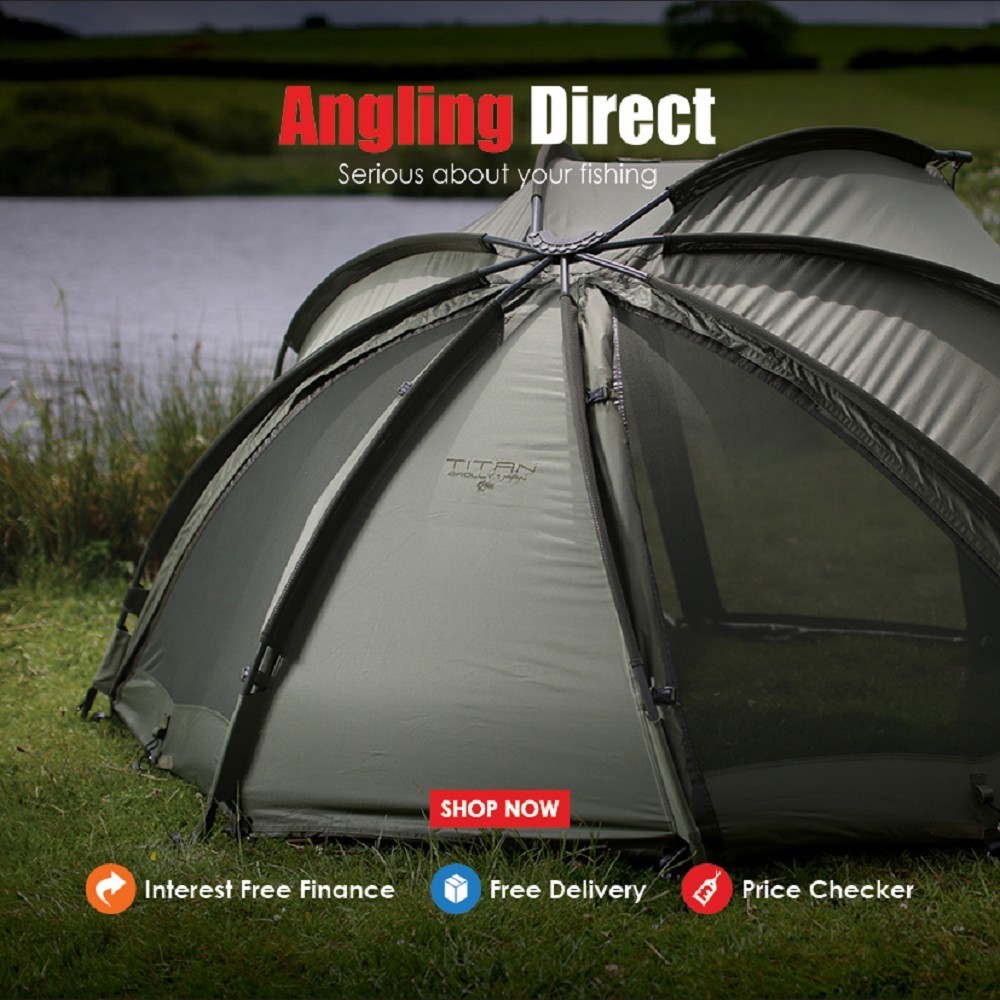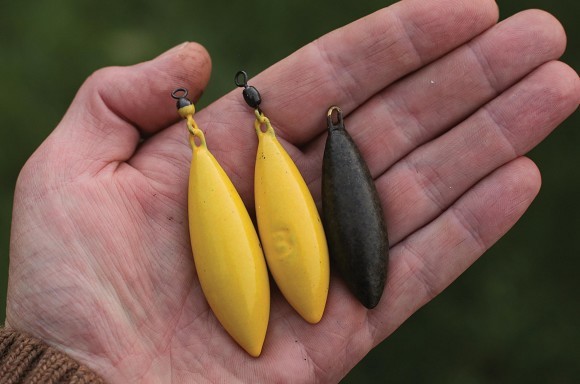
Does lead coating and colour make a difference?
Terry Hearn offers up his thoughts on lead colour and coating...
Question
“Here’s one for all of you, lead colour and coating appearance, what’s your views on both and how much do you really think it matters? We’ve all come across those scenarios where the last few battered up leads are in the bottom of the carryall and you’ve had no choice but to use one of them, going on to still catch. I know that some anglers swear by using bright coloured leads such as white with the idea of adding extra visual attraction. What’s your experiences of just how much of a difference it makes by trying to blend in and how do you really know what the lakebed looks like out in the middle of the lake? Surely placing a rig in the margin isn’t a good enough comparison? Your thoughts please…”
The same applies for all my end tackle, I’m not one for changing lead, leader or hooklink colour according to whether I’m fishing on silt or gravel, as I’d be changing back and forth all the time. All I want my end tackle to do is look natural, no different to a twig or any other debris laying on the bottom, and to do that it doesn’t have to become invisible. Looking at the two extremes, dark or pale, dark is better in my book. I’d be much happier with a darker hooklink over, let’s say a pale, sandy or clay coloured bottom, than I would be with a pale hooklink on a dark silty bottom. Saying that, I remember catching plenty of carp on the old Kryston Silkworm many years ago, and that stuff was almost white, so who knows.
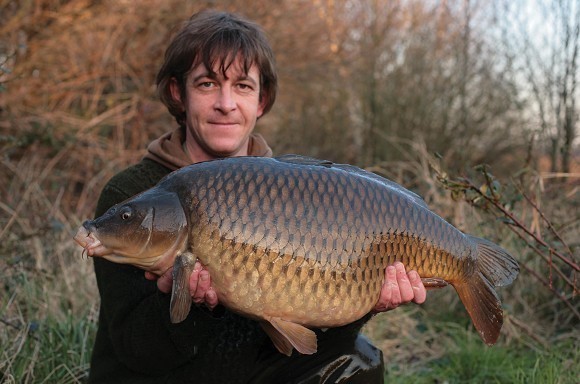 One from The Doughnut. Here the water was really clear so I took the time to coat up some of my own leads to suit the clean gravel ledge
One from The Doughnut. Here the water was really clear so I took the time to coat up some of my own leads to suit the clean gravel ledgeObviously the clearer and shallower the water is, the more attention I tend to pay to that sort of thing. At Frimley Pit 4 I once remember dropping a rather silvery coloured hook into the edge in shallow water and then taking a few steps back. I was still able to see it from fifteen-feet away, which was enough to make me change over to a hook with the old fashioned black nickel coating instead.
Still at Pit 4, I also coated up my own leads in brown to best match the shallow gravel shelf, and I did away with the leadcore altogether, instead opting for blobs of putty up the main line to help keep it pinned to the deck. Whether any of it made much difference it’s hard to say, but I caught a few like it. I think a lot of it is confidence, but either way, it’s nice to drop a rig on a spot in the edge and struggle to see it.
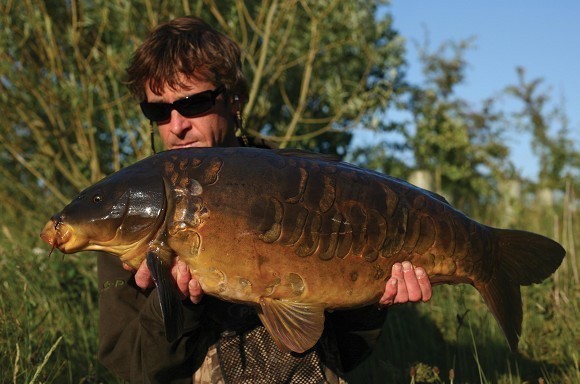 Another lovely clear water carp, this time from a large Oxfordshire pit. Here the carp were relatively un-pressured and so I wasn’t so fussed about end tackle concealment
Another lovely clear water carp, this time from a large Oxfordshire pit. Here the carp were relatively un-pressured and so I wasn’t so fussed about end tackle concealmentTalking of brightly coloured leads, I have played with them on the Thames. It was my mate Dave that tried them first, in white, mainly as a visual casting aid when chucking across to boats on the far side. He carried on catching no different to when he was using normal leads, and so I got on the phone to Simon from Atomic and he kindly made us up a load of bright yellow ones. Again, they worked just fine, in fact, with the un-pressured carp in the river (back then at least) there were times when we reasoned that the extra splash of colour might even have been helping to turn their heads. Obviously it’s hard to come to any firm conclusions with something like that as there’s so much else at play, and to be honest, when fishing off the boat was at its best we could have caught them using spark plugs as weights.
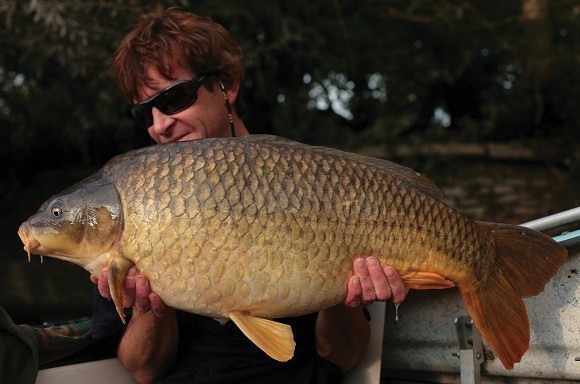 One off the boat. Yellow leads worked just fine and in certain light conditions they made casting towards boats on the far side a little easier. Grandad’s homemade tablespoon leads caught just as well though!
One off the boat. Yellow leads worked just fine and in certain light conditions they made casting towards boats on the far side a little easier. Grandad’s homemade tablespoon leads caught just as well though!At one point I ran out of leads suitable for clips, but rummaging around in the shed I came across a bag of granddad’s old sea leads. There were all sorts of shapes and sizes, proper uncoated rough and ready jobs, made with Worthing and Dungeness in mind, not Twickenham and Teddington. The spoon-shaped ones were my favourite, and I could see that they’d actually been made using a tablespoon as a mould. They had a fancy 70’s pattern on one side and they cast out about as accurately as a boomerang, but so long as I caught the lead hard and gave it a bit of a yank as it hit the surface to straighten out the rig, they worked just fine. Caught loads on those, old granddad would have been proud.



